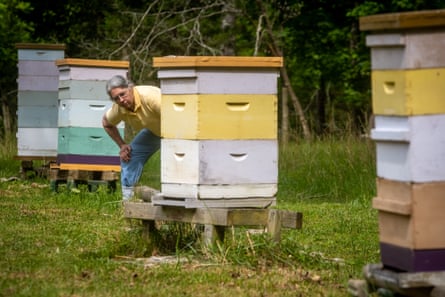I’m a vet for bees – I think I might be the only one in the US
I’m an only child and grew up in the US in a time when children were free-range. My parents would open the door in the morning and say, “come back for meals.” I would disappear into the forest and wetlands. I loved the constant stories around me that I didn’t understand: the stories of animals.
When I was about seven there was a litter of kittens in the house, and a board crushed one of the kittens. The vet examined her mouth and said, “she’s not going to make it”, and minutes later she died in his hands. I couldn’t understand how he knew that – I wanted that superpower to understand animals, and that is why I wanted to become a vet. I got a degree and have been working as an environmental health scientist for more than 25 years.
In 2017, because of concerns about antibiotic resistance in humans, the US government changed the rules, which meant beekeepers could no longer buy the drugs over the counter. So they needed a veterinarian to prescribe them, and that’s why I decided to create a veterinary practice for bees.
 View image in fullscreenElizabeth Hilborn checking hives in Orange county, North Carolina Photograph: Kate Medley
View image in fullscreenElizabeth Hilborn checking hives in Orange county, North Carolina Photograph: Kate MedleyThis may make me unique in the US – I don’t know anyone else who is just a bee vet. I’ve been growing fruit my whole life, and I wanted to support bees and the people that keep them. I work evenings, weekends and holidays around my day job. I love pollinators; it is such a pleasure and privilege to work with them, so it doesn’t seem like work.
I have clients who have worked with bees for a long time. They say: “I’m seeing brown larvae, it doesn’t smell right, can you come look?” I suit up and I look at their healthy hives first – I’m examining the whole area, looking at bees coming and going, getting a sense of how they look. Then we go to the ones we suspect to be diseased. To avoid stings, I go in there quietly and respectfully, and that makes the bees comfortable. A common disease is European foulbrood. You can often smell it – it’s almost sweet and musky.
 View image in fullscreenHilborn with her hive checklist Photograph: Kate Medley
View image in fullscreenHilborn with her hive checklist Photograph: Kate MedleyOnce I’ve settled on a diagnosis, I give them something which is like a prescription – the beekeepers get the antibiotics and mix it with powdered sugar, which the bees eat.
We’ve had terrible weather here. If bees are struggling to find food that can put them at risk of disease. European foulbrood kills the babies. The queen survives, but over weeks or months the colony fails.
The jetstream is much less stable than it used to be. For example, last February was really warm, and wild bees were coming out of hibernation and there was nothing there for them to eat. This is one of the leading risks to bee health – this mismatch in timing. They need access to flowers, but the flowers are not out. This is a huge stressor on animal populations in general.
 View image in fullscreenChecking on the health of a hive. Honeybees are protected in their hives in a way that wild bees aren’t, which Hilborn says is a worry Photograph: Kate Medley
View image in fullscreenChecking on the health of a hive. Honeybees are protected in their hives in a way that wild bees aren’t, which Hilborn says is a worry Photograph: Kate MedleyMy first approach to learning this profession was books, but books can only take you so far. I started hanging out with beekeepers and apiarists and then I joined my local bee club.
Honeybees are protected from some environmental pressures because we house them, we feed them, we care for them. It is the wild bees I’m extremely worried about: they don’t have anyone to care for them – they depend on how well the environment is supporting them. I’m concerned about the erratic weather; we have some trends which make it very difficult for honeybees and wild bees.
I feel like every bee is so precious now, especially early in the year. That is often when the wild bee queens are out and may be distressed. And by saving her, that can save a whole colony. So there’s a lot resting on that one bee: if I can help her, I will.
As told to Phoebe Weston
Between 24 March and 2 April, we will be profiling a shortlist of 10 of the invertebrates chosen by readers and selected by our wildlife writers from more than 2,500 nominations. The voting for our 2025 invertebrate of the year will run from midday on Wednesday 2 April until midday on Friday 4 April

댓글
댓글 쓰기